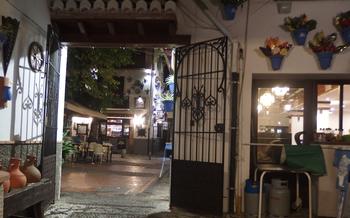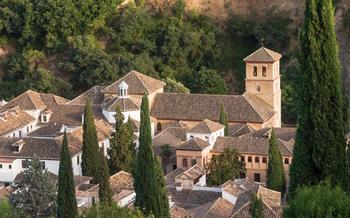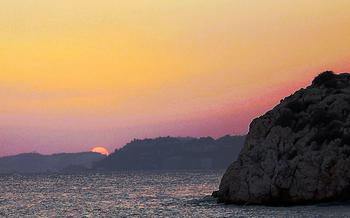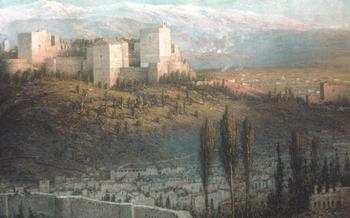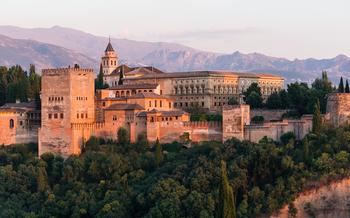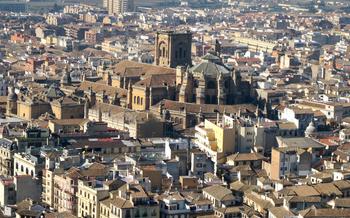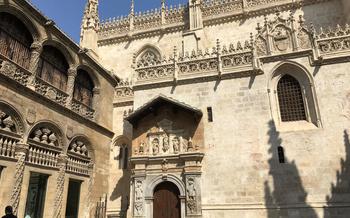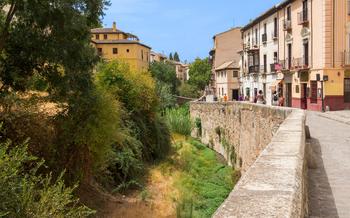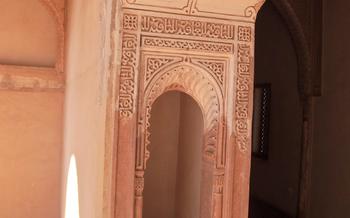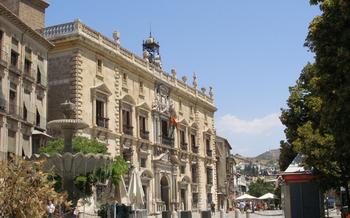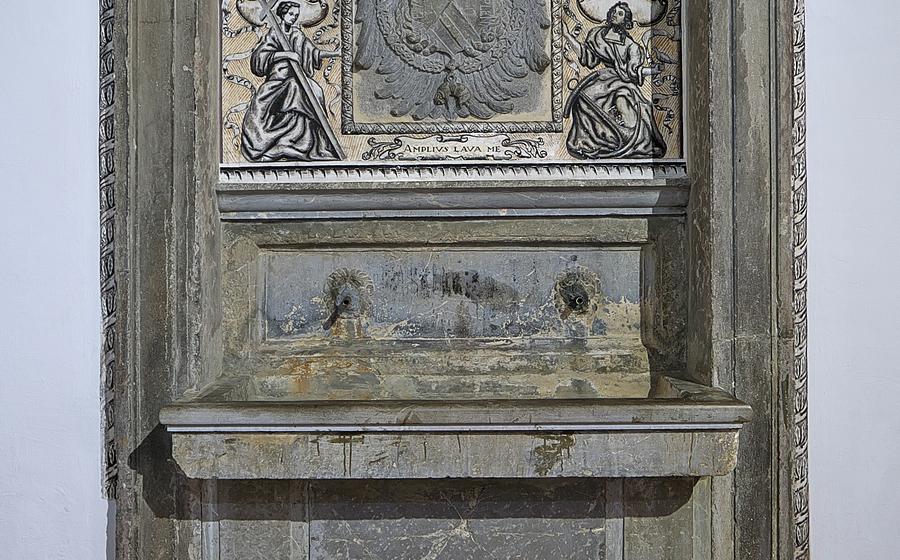
Monastery of San Jerónimo
- Historical Significance
- Location and Getting There:
- Architectural Beauty
- Royal Pantheon
- Monastic Life
- Artistic Treasures
- Guided Tours and Accessibility
- Sanctuary of San Jerónimo
- Cultural Events and Exhibitions
- Nearby Attractions
- Practical Tips and Etiquette
- Audio Guides and Multimedia
- Virtual Tours and Online Resources
- Insider Tip
Historical Significance
Founded in the 15th century by the Catholic Monarchs, the Monastery of San Jerónimo stands as a testament to Granada's rich history and cultural heritage. This magnificent edifice served as a royal pantheon, housing the tombs of prominent figures like Gonzalo Fernández de Córdoba, known as "El Gran Capitán." Its architectural style seamlessly blends Gothic, Renaissance, and Mudejar elements, reflecting the diverse influences that shaped Granada's identity. Within its walls, the stories of the monks who dedicated their lives to religious devotion and scholarship unfold, inviting visitors to immerse themselves in the spiritual and cultural legacy of this sacred site.
Location and Getting There:
The Monastery of San Jerónimo is situated in the heart of the historic Albaicín neighborhood of Granada, Spain. Visitors can easily reach the monastery by foot from the city center, following a pleasant 15-minute walk through the picturesque streets and alleys of Albaicín. The monastery is located at the end of Calle Oficios, just a short distance from the Plaza Nueva.
Alternatively, visitors can take public transportation to reach the monastery. The C3 bus line stops right outside the monastery's entrance, making it a convenient option for those who prefer not to walk.
To enhance their visit, travelers can combine their trip to the Monastery of San Jerónimo with other nearby attractions in the Albaicín neighborhood. The Mirador de San Nicolás, offering breathtaking views of the Alhambra and the Sierra Nevada mountains, is just a short walk away. The Plaza Larga, with its lively atmosphere and numerous restaurants and shops, is also within easy reach.
For the best experience, it is advisable to visit the monastery during the shoulder seasons (spring or fall) to avoid the summer crowds. During these periods, visitors can enjoy a more peaceful and intimate exploration of the monastery's tranquil spaces.
Architectural Beauty
The Monastery of San Jerónimo stands as a testament to the architectural prowess of the Spanish Renaissance, blending Gothic, Renaissance, and Mudejar elements into a harmonious masterpiece. Its exterior boasts intricate stone carvings, delicate arches, and a magnificent bell tower that dominates the skyline of Granada. Inside, visitors are greeted by elegant cloisters adorned with graceful columns and arches, creating a serene and contemplative atmosphere. The monastery houses an impressive collection of artwork and religious artifacts, including paintings by Alonso Cano, sculptures by Pedro de Mena, and an altarpiece by Juan de Mena. These artistic treasures, combined with the stunning architecture, make the Monastery of San Jerónimo a feast for the eyes and a must-visit destination for anyone interested in Spanish art and history.
Royal Pantheon
The Monastery of San Jerónimo holds a significant place in Spanish history as a royal pantheon, where several members of the Spanish royal family found their final resting place. Among the most notable tombs is that of Gonzalo Fernández de Córdoba, known as "El Gran Capitán." A legendary military leader, El Gran Capitán played a crucial role in the Spanish Reconquista, leading Christian forces to victory against the Moors. His elaborate tomb, adorned with intricate carvings and sculptures, stands as a testament to his military prowess and the gratitude of the Spanish monarchy.
Other notable tombs include those of King Ferdinand V and Queen Isabella I, the Catholic Monarchs who founded the monastery, and their daughter, Queen Juana I of Castile. The royal tombs are adorned with exquisite decorations, featuring colorful tiles, intricate carvings, and life-sized sculptures that depict the deceased in their royal regalia. These tombs not only serve as memorials to the departed monarchs but also offer a glimpse into the grandeur and opulence of the Spanish monarchy during the Renaissance period.
Monastic Life
Within the walls of the Monastery of San Jerónimo, a vibrant community of monks once thrived, following the strict rules and rituals of the Hieronymite order. Their days began at dawn with prayers and meditation, seeking spiritual enlightenment through contemplation and study of sacred texts. The monks dedicated themselves to a life of austerity, humility, and obedience, finding solace in the simplicity of their existence.
Beyond their religious duties, the monks played a vital role in the community, providing spiritual guidance, education, and charity to the people of Granada. They established a renowned school within the monastery, where young boys from all walks of life received an education in theology, philosophy, and the arts. The monks also tended to the sick and needy, offering medical care and assistance to those in distress.
One of the most fascinating aspects of monastic life was the monks' dedication to craftsmanship and artistic pursuits. They were skilled in a variety of arts, including woodworking, metalworking, painting, and embroidery. The monastery's workshops produced exquisite religious objects, such as intricate altarpieces, finely crafted chalices, and ornate vestments. These works of art not only adorned the monastery's interior but also served as a source of income, helping to sustain the community.
The monks of the Monastery of San Jerónimo lived a life of devotion and service, leaving an enduring legacy on the cultural and spiritual landscape of Granada. Their contributions to education, healthcare, and the arts continue to inspire and enrich the lives of those who visit this historic monastery.
Artistic Treasures
The Monastery of San Jerónimo is home to a remarkable collection of artwork and religious artifacts that showcase the artistic prowess of the Spanish Renaissance. Visitors can admire the stunning altarpiece by Juan de Mena, a masterpiece of Gothic art featuring intricate carvings and vibrant colors. The paintings by Alonso Cano, a renowned artist of the Baroque period, depict religious scenes with a sense of realism and emotional depth. The sculptures by Pedro de Mena, another prominent Baroque artist, display a mastery of form and expression, capturing the essence of religious figures and saints. These artistic treasures, along with numerous other paintings, sculptures, and tapestries, offer a glimpse into the artistic and spiritual life of the monastery during its heyday.
Guided Tours and Accessibility
Guided tours of the Monastery of San Jerónimo are a fantastic way to delve deeper into its rich history and significance. Knowledgeable guides will lead you through the monastery's halls, chapels, and courtyards, sharing captivating stories and anecdotes that bring its past to life. Tours are available in multiple languages, ensuring that visitors from all over the world can appreciate the monastery's wonders.
For those with accessibility concerns, the monastery is well-equipped to accommodate visitors with disabilities. Wheelchair ramps and elevators provide easy access to all areas of the monastery, and audio guides are available for visitors who are deaf or hard of hearing. The monastery's staff is also incredibly accommodating and will do their utmost to ensure that everyone has a comfortable and enjoyable visit.
To make the most of your visit, it's advisable to book your guided tour in advance, especially during peak tourist season. Guided tours typically last around an hour, and it's recommended to arrive a few minutes early to ensure you don't miss the start. Whether you're a history buff, an art enthusiast, or simply someone who appreciates beautiful architecture, a guided tour of the Monastery of San Jerónimo is an experience you won't forget.
Sanctuary of San Jerónimo
Within the monastery complex lies the beautiful Sanctuary of San Jerónimo, a sacred space dedicated to the patron saint of translators and scholars. Its architectural features are awe-inspiring, with an intricate altar, an ornate dome, and stunning stained-glass windows that bathe the interior in a kaleidoscope of colors. Pilgrims from around the world are drawn to this sanctuary, seeking solace, guidance, and a connection with the divine. Legends and stories of miracles and answered prayers abound, adding to the mystical allure of this sacred site.
Cultural Events and Exhibitions
The Monastery of San Jerónimo occasionally hosts a variety of cultural events, concerts, and exhibitions that showcase the diverse cultural heritage of Granada. These events transform the monastery into a vibrant hub of artistic expression, attracting visitors from all over the world.
From classical music concerts held in the echoing cloisters to art exhibitions showcasing the works of local and international artists, the monastery offers a unique platform for cultural exchange and appreciation. Visitors can immerse themselves in the rich tapestry of Spanish culture through these events, gaining a deeper understanding of the region's artistic traditions and contemporary expressions.
Historical reenactments, workshops, and lectures also take place within the monastery walls, providing visitors with an interactive and engaging way to learn about the monastery's past and its significance in Spanish history. These events offer a glimpse into the lives of the monks who once resided here, their contributions to society, and the enduring legacy of the Monastery of San Jerónimo.
To find out about upcoming events, visitors can check the monastery's official website or contact the tourist information office in Granada. Advance booking is recommended for popular events, especially during peak tourist season. Attending a cultural event or exhibition at the Monastery of San Jerónimo is an unforgettable experience that allows visitors to connect with the vibrant cultural spirit of Granada and discover the hidden treasures of this historic site.
Nearby Attractions
A visit to the Monastery of San Jerónimo can be easily combined with other nearby attractions, allowing visitors to immerse themselves in Granada's rich cultural heritage. The iconic Alhambra Palace, a UNESCO World Heritage site, is just a short walk away, offering visitors a glimpse into the grandeur of the Nasrid dynasty. The Granada Cathedral, with its stunning Gothic architecture and impressive interior, is another must-see attraction.
For those interested in exploring Granada's historic neighborhoods, the Albaicín district, with its narrow cobbled streets, whitewashed houses, and vibrant atmosphere, is a must-visit. Visitors can wander through the picturesque streets, admire the traditional architecture, and soak up the unique charm of this historic quarter.
After a day of sightseeing, visitors can relax and refuel at one of the many restaurants, cafes, or tapas bars in the vicinity of the monastery. From traditional Spanish cuisine to international flavors, there are plenty of options to satisfy every palate. Whether you're looking for a quick bite or a leisurely meal, you'll find something to your liking in the surrounding area.
Practical Tips and Etiquette
When visiting the Monastery of San Jerónimo, it is essential to be respectful of its religious nature and the ongoing activities of the monks. Appropriate attire is recommended, such as covering shoulders and knees, and maintaining a modest demeanor. Visitors should avoid loud noises, disruptive behavior, or using flash photography within the monastery's sacred spaces. It is crucial to remember that the monastery is an active place of worship and contemplation for the monks, and visitors should be mindful of their presence. Photography is generally permitted in the monastery's public areas, but it is essential to be respectful and avoid capturing images of individuals without their consent. Visitors are encouraged to ask permission before taking photographs in specific areas, such as the cloisters or the sanctuary. By following these simple guidelines, visitors can help preserve the tranquil atmosphere of the monastery and ensure a pleasant experience for all.
Audio Guides and Multimedia
Enhance your visit to the Monastery of San Jerónimo with the help of audio guides or multimedia tours. These tools provide a wealth of information and insights, transforming your experience into a journey of discovery.
With audio guides, you can listen to personalized commentary as you explore the monastery's various sections. Detailed explanations and historical anecdotes bring the monastery's rich past to life, allowing you to delve deeper into its significance.
Multimedia tours offer an even more immersive experience, combining audio commentary with visual presentations, interactive maps, and 3D reconstructions. These tours are particularly useful for understanding the monastery's architectural details and its role in the broader history of Granada.
Audio guides and multimedia tours are available in several languages, ensuring accessibility for visitors from around the world. You can rent these devices at the monastery's entrance or download the accompanying apps to your smartphone or tablet.
Embrace the opportunity to enhance your visit with these technological tools. Let the voices of history guide you as you uncover the secrets of the Monastery of San Jerónimo.
Virtual Tours and Online Resources
In the digital age, visitors can explore the Monastery of San Jerónimo virtually from the comfort of their homes. Several websites and platforms offer immersive virtual tours that allow users to navigate through the monastery's stunning interiors, courtyards, and gardens. These tours feature high-quality 360-degree panoramas, detailed historical information, and interactive maps. Visitors can zoom in on intricate architectural details, admire the artwork up close, and learn about the monastery's rich history at their own pace. Virtual tours are an excellent resource for those who are unable to travel or who want to preview the monastery before their visit. Explore the Monastery of San Jerónimo virtually through the official website of the Junta de Andalucía or on platforms like Google Arts & Culture for an immersive and educational experience.
Insider Tip
Beyond the main tourist areas of the Monastery of San Jerónimo lies a hidden gem that many visitors overlook: the serene and beautifully preserved cloister garden. This tranquil oasis, tucked away from the hustle and bustle of the city, offers a unique opportunity to experience the monastery's peaceful ambiance and immerse oneself in its rich history. Take a moment to wander through the garden, admiring the lush greenery, fragrant flowers, and intricate stone carvings that adorn the cloisters. Find a quiet spot to sit and reflect, allowing the tranquility of the surroundings to wash away the stresses of everyday life. The cloister garden is a true hidden treasure, offering visitors a glimpse into the contemplative and spiritual heart of the monastery.
